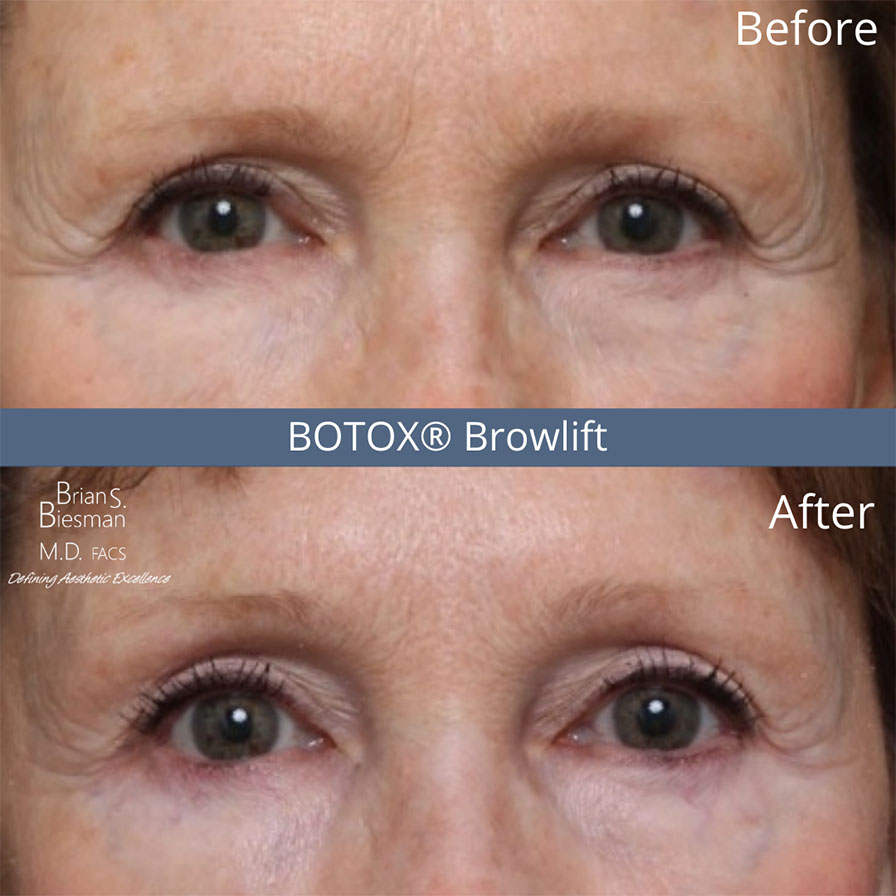Botox® is injected into the skin to relax specific muscles or muscle groups. It is manufactured in a laboratory and not harvested from animals or other people. Once injected, it works by affecting communication between nerve endings and muscle fibers at the treatment site. Safe and simple, Botox procedures take place right in the office and typically yield results within a few days.
Typical Applications
Facial applications of Botox include relaxation of the vertical lines between the eyebrows, smoothing of wrinkles in the forehead and crow’s feet (corners of the eyes), elevation of the eyebrows and corners of the mouth, improvement of unwanted lines in the lips and on the neck, contouring the jawline, and more. Following a Botox injection, the treated muscles gradually become relaxed, allowing the overlying skin to appear smooth and unwrinkled, while untreated muscles are not affected. It does not act to fill in deep lines; it only relaxes muscles. Botox complements injectable fillers such as Restylane and Juvederm.
How Botox Treatment Works
A tiny microneedle is used to deliver a minute, exact amount of Botox into several locations on the face. Because the needle is so fine and the amount of liquid injected is so small, the discomfort associated with injections is minimal. Sedation or anesthesia is not required for Botox injections, and no special recovery period is required. Any mild bruising that may occur at the injection sites may be covered with makeup.
What to Expect after Treatment
The result of a Botox injection usually becomes apparent within three to five days, with maximum benefit occurring within two weeks and effects generally lasting from three to six months. Injections are given when the effects of the previous treatment begin to wear off. Initially, patients receive from two to four treatments per year. After receiving several treatments, many patients find that they require Botox even less often. In rare cases, some even find that they have achieved a permanent improvement.

Possible Side Effects of Botox
The side effects of Botox are minimal and not permanent. Each molecule of Botox is relatively large and thus does not migrate far from its injection site; consequently, the effects of a Botox injection are limited to the area into which it is delivered. What’s important to keep in mind, however, is that Botox treatments are extremely technique dependent. This means it is important that injections be administered by experienced individuals such as Dr. Biesman or his nurse injector Molly Katz, RN. Dr. Biesman administered his first Botox injection in 1989 and has performed tens of thousands of Botox treatments since then. Dr. Biesman developed a rigorous and extensive training program for Molly and only authorized her to administer injections once she demonstrated an extraordinary level of skill.
When used appropriately and in proper doses, Botox is an extremely safe drug. There is no lifetime limit to the number of Botox injections a patient may receive, as the drug does not build up or “accumulate” in a person’s system.
The History of Botox
Despite its widespread popularity today, surprisingly, Botox is still widely misunderstood. Understanding this drug’s background and history lend some insight into its popularity today. Here’s are some highlights of its history:
- 1979: Botox was first approved for use by the Food and Drug Administration for the treatment of “crossed eyes”. Shortly thereafter approval was granted for treatment of involuntary facial spasms.
- 1990: The first use of Botox to improve the appearance of facial wrinkles and lines was reported around 1990.
- Today: There are over 100 medical applications of this fascinating drug.
